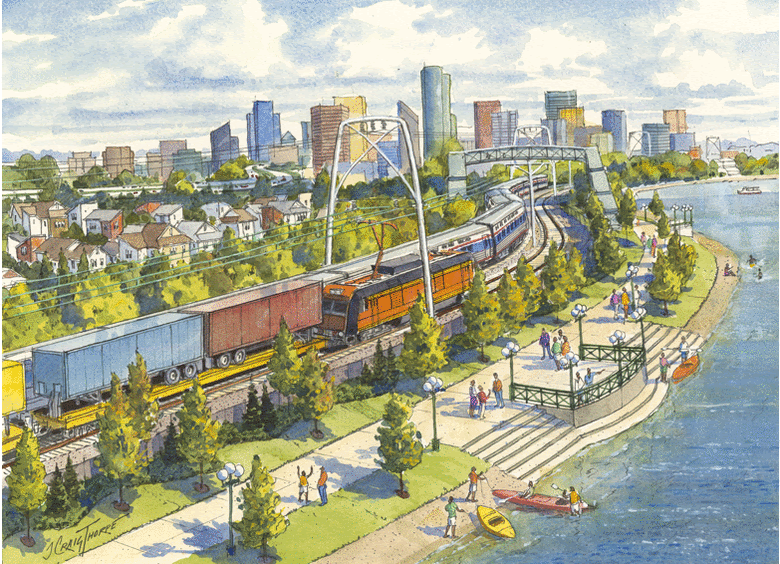Here's more from past rail studies related to 110MPH optimal speed for the north/south corridor from Vancouver, BC to Portland, OR.
Here's the GOOGLE Folder with Long Range WS DOT Rail Study Archive
The legislature commissioned work on high speed ground transportation in Washington in 1984.
The result was that for many reasons, the high speed trains that we in the US call bullet trains did not make sense for Washington. Before the final report was completed, the Legislature followed that advice and commissioned work on the incremental improvement, medium-high speed service. That work continued through 2007. The work in this plan was the basis for the $800 million ARRA grant that Washington received.
The first volume is the plan description. It describes the plan in detail in text and tables. The plan description is derived from the seven technical documents. The main document is still available on the WSDOT website, but the technical papers are not.
In Vol 1 Operating and Infrastructure Plan.pdf you will find a complete history of the development of the program:
In Vol 1 Operating and Infrastructure Plan.pdf you will find a complete history of the development of the program:
Appendix A pages A-5 - A-34. This body of work was not a case of several studies of the same thing. As the program progressed, each work became the basis for the next work, increasing the details.
In the main document, Long Range Plan for Amtrak Cascades.pdf,
110 mph speed is discussed on:
1-7, 4-3, 5-7, 5-9, 5-10, 5-18, 5-21, 5-22, 5-30, 5-31, A-13, A-17, A-21
Service north of Seattle is discussed on:
3-3, 3-4, 3-5, 3-6, 3-8, 3-9, 3-11, 3-12, 4-13, 4-14, 4-15 ,5-7 -- 5-12, 5-30, 5-32, A-1, A-4, A-7, A-8, A-11, A-12, A-15, A-16, A-19, A-20, B-4, B-5D-18 -- 26, Appendix E
In Vol 1 Operating and Infrastructure Plan.pdf
110 mph speed is discussed on:
2-12, 2-13, 4-12, 4-18, 4-33, 4-36, 4-37, 4-38, 4-41, 4-42, 4-45, 4-46, 4-47
The timetables for the planned service between Vancouver BC and Everett are on pages H-1, H-5, H-9, H-13, H-17, H-21, I-1
The plan includes integration with Sounder commuter service. Examples of the integrated service are found on G-27, G-31, G39, G-40, G-48, G-49, G-56, G-57, G-63, G-64.
There is yet more detail in the volumes. Cost information, a decade old, is, of course, currently obsolete. The projects that have been constructed with the ARRA grant and the associated service does not match the plan as it was necessary to go outside of the phasing and modify some projects to make best use of the available funds.
In the main document, Long Range Plan for Amtrak Cascades.pdf,
110 mph speed is discussed on:
1-7, 4-3, 5-7, 5-9, 5-10, 5-18, 5-21, 5-22, 5-30, 5-31, A-13, A-17, A-21
Service north of Seattle is discussed on:
3-3, 3-4, 3-5, 3-6, 3-8, 3-9, 3-11, 3-12, 4-13, 4-14, 4-15 ,5-7 -- 5-12, 5-30, 5-32, A-1, A-4, A-7, A-8, A-11, A-12, A-15, A-16, A-19, A-20, B-4, B-5D-18 -- 26, Appendix E
In Vol 1 Operating and Infrastructure Plan.pdf
110 mph speed is discussed on:
2-12, 2-13, 4-12, 4-18, 4-33, 4-36, 4-37, 4-38, 4-41, 4-42, 4-45, 4-46, 4-47
The timetables for the planned service between Vancouver BC and Everett are on pages H-1, H-5, H-9, H-13, H-17, H-21, I-1
The plan includes integration with Sounder commuter service. Examples of the integrated service are found on G-27, G-31, G39, G-40, G-48, G-49, G-56, G-57, G-63, G-64.
There is yet more detail in the volumes. Cost information, a decade old, is, of course, currently obsolete. The projects that have been constructed with the ARRA grant and the associated service does not match the plan as it was necessary to go outside of the phasing and modify some projects to make best use of the available funds.
A few simple initial thoughts re DOT Ultra-High Speed Rail Report.
This was a rushed study, open only to pre-selected list of contractors. Still, the $300k seems like a high price for the information gleaned.
Questions about data, variables, conclusions:
In general, it seems to me that Washington State is failing to ask the right questions in regards to:Page 3:Why was Hyperloop included (and then excluded)?This seems to reflect politic$ rather than common sense.Page 3&5:What was the optimal speed relative to each scenario?The max speed for each technology is listed, but there's no indication of the optimal speed for each scenario (3 city, 4 city, 7 city). (I will look for old DOT rail study data on this). this is important due to the cost of NEW RoW, and the fact that existing rail technologies are already capable of accommodating 110 MPH.Since we know that past studies determined 110mph to be the optimal speed for the corridor, that should have been part of the analysis.Page 5:How is it possible that the maglev is both more expensive AND is paid off as much as 20 years earlier than High Speed Rail? [The explanation given was operating costs of maglev were less. It seems unbelievable that they are 20 years less]Page 6:Hints at increases in service by Amtrak. What is being said here? Wasn't $800 mil. spent on Sea to PDX corridor with only 15min travel time improvement?
Lastly, the Connect modelling tool was unable to be applied to trips shorter than 50 miles apart. So what did they actually learn about Lacey, Tacoma, Seattle, Everett aspect of the route?
- rail (passenger and freight) transportation,
- the decarbonization of transportation sector and the role of rail business model to truck electrification; and
- the relationship to transmission and our grid.
- (And economic and environmental sustainability)
I hope you will consider working with us to support a study of the Solutionary Rail approach to addressing these challenges.

